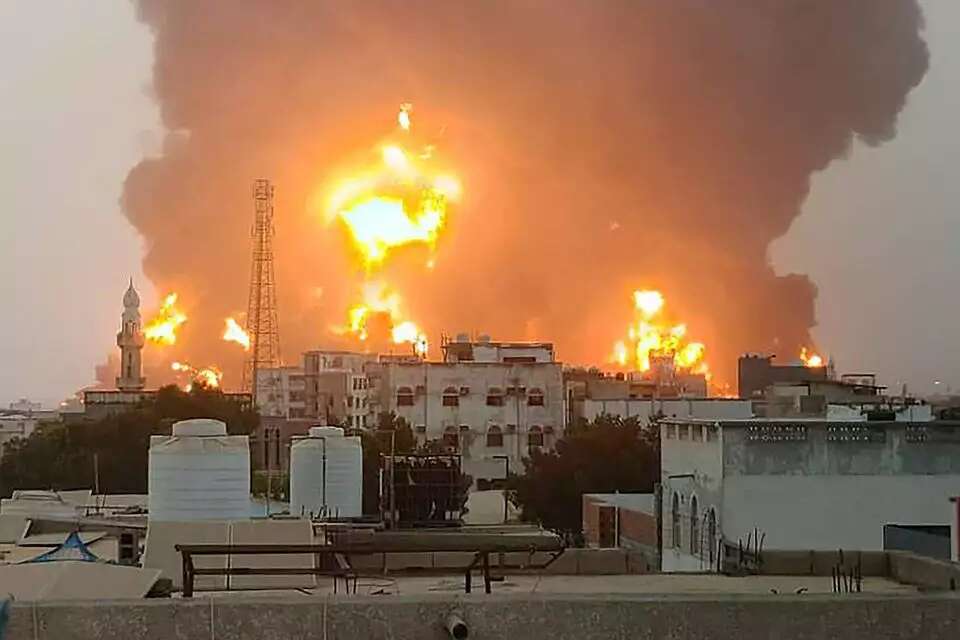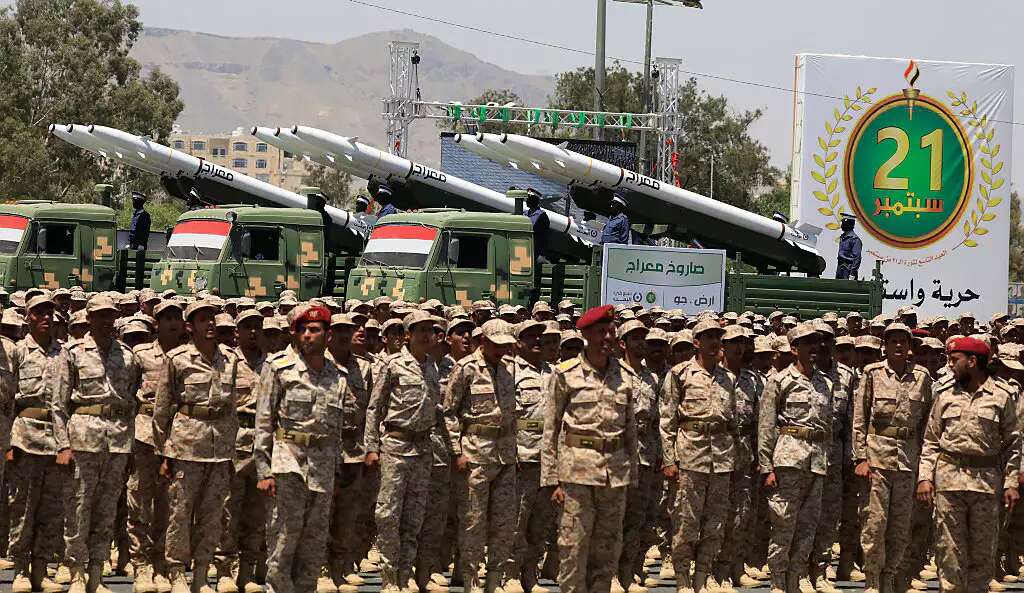Israel's Yemen strike caused millions in damage to Houthis
The impact of Operation "Long Arm" is not just in creating a deterrent and causing psychological damage, but mainly aimed at disrupting the lifeline of the Houthi economy. What was the cost of the operation for Israel, and what enormous economic damage did the Houthis suffer?
Israel Shamay and Makor Rishon
Israel Hayom
Jul 25, 2024
Israeli Air Force planes attacked Al-Hudaydah port, causing massive amounts of damage.
$3 million per day - this is, according to estimates, the astronomical sum the Houthis earn through the use of the Al-Hudaydah port, the main artery of their economy, through which the terrorist organization imports goods, food, and Iranian weapons.
Last Saturday, Israeli Air Force planes attacked Al-Hudaydah port, causing massive amounts of damage. What were the targets, what is the extent of the damage caused to the Houthis as a result of the strike compared to the estimated cost of the Israeli strike, and what is the recent history of Al-Hudaydah in the Yemeni war? Why did the UAE try to conquer it as early as 2016?
The cost of the operation
According to the IDF and various reports in Yemen, Israeli Air Force planes hit Houthi military sites used for storing weapons from Iran, oil facilities, and the Ras Al-Khatib power station – a bombing that caused an enormous fire, followed by widespread power outages.
According to several sources, including Sky News in Arabic and the Egyptian news site "Al-Balad," the IDF hit 20 fuel storage facilities, most of which were within the port itself.

"We attacked the port area because it is a supply route for transferring weapons from Iran to Yemen and a significant economic source for Houthi terrorism," said IDF Spokesperson Brigadier General Daniel Hagari regarding Operation "Long Arm." The main goal of the attack on Al-Hudaydah port, according to Hagari, was economic damage to the Houthis – hence it is important to examine the economic damage in this context compared to the cost.
The Al Jazeera website in Arabic reported: "The damage caused by the attack on the Al-Hudaydah port is still unclear. The extent of the damage may reduce its ability to transport goods and even lead to its cessation. According to local media estimates in Yemen, the Houthis earn more than $3 million a day from imports and sales, so they are expected to lose a significant portion of their income."
The extent of the damage will depend on the Houthis' ability to continue frequent trade, the amount and type of weapons destroyed, the damage caused by the power outage and fires, and of course, the port's reconstruction, which Israeli sources estimate will take between six months to a year. The Houthi rebel government's electricity minister, Mohammed Al-Bukhaiti, confirmed that the attack caused significant damage.
A time for numbers
So, how much did the attack cost us, and what is the estimated damage the Houthis are expected to suffer?
The operational cost of an F-35 aircraft without fuel expenses is estimated at about $31,000 per hour, while that of an F-15 reaches around $29,000 per hour without fuel. The estimated fuel cost is about $14,300 per flight hour for the F-35 and about $29,000 for the F-15. Thus, the cost per flight hour of each F-35 is about $45,300, and for the F-15, it is about $38,600.
The first planes took off at 15:10, and the bombing itself occurred at 18:00, meaning they flew for about two hours and 50 minutes each way, totaling about 5 hours and 40 minutes.
As far as is known at this stage, 18 planes participated in the attack, most of them F-35s alongside a few F-15s. Since it is not known how many planes were of each type, it is impossible to know precisely the cost of their use. However, by calculating the operational and fuel costs multiplied by the number of flight hours, it can be estimated that it was around $4.4 million.
In addition to this amount, we must account for the operational and fuel costs of several refueling planes ("Ram"), F-16 aircraft, reconnaissance planes ("Nachshon"), and transport planes ("Shimshon"), the operation of naval vessels that supported the aerial forces from the Red Sea, and of course the cost of the munitions themselves, which can range from hundreds of thousands to millions. Conservatively, it can be said that the historic Israeli attack on Yemen probably cost at least $6 million and may have exceeded $8-10 million, depending on the number of planes and additional equipment involved, the type of munitions, and their quantities, and more.
Potential damage in the hundreds of millions of dollars
On the other hand, as mentioned earlier, the Houthis earn about $3 million a day from Al-Hudaydah port, and its reconstruction is expected to take between six months to a year. According to Al Jazeera, the damage may affect the port's ability to transport goods and even shut it down entirely.
A complete shutdown of the port would force the Houthis to move all trade to the Salif and Ras Issa ports, which would not be able to handle such volumes of goods. In a scenario where Al-Hudaydah port's cargo capacity is reduced by 20% for six months, the Houthis would lose about $108 million in trade alone.
In a more severe scenario for them, where the port is shut down for a year, while in the two weeks during which trade freezes, they manage to transfer 75% of it to the two smaller ports until Al-Hudaydah is restored – the Houthis would lose about $312 million.
Alongside the trade damage, the costs of restoring the power station, storage facilities, and more, which could reach tens of millions of dollars, must be considered. Finally, the direct damage from the bombing, as recent satellite images from the Israeli EROS B satellite revealed that about two-thirds of the oil and fuel reserves at Al-Hudaydah port were destroyed. Din Shmuel Elmas wrote in Globes that the direct damage to the port would reach about $100 million, separate from the indirect damage mentioned earlier.
On the other hand, the New York Times published yesterday (Sunday) that according to experts in Yemeni studies, the attack is not expected to deter the Houthis from attacking Israel again and might even strengthen their motivation to do so. They estimated that the Houthis might gain political strength in Yemen and the Arab world, while the Yemeni citizens would suffer from the attack.
However, the article did not consider the economic damage to the Houthis, which could be enormous for a terrorist organization from a poor country that has been in a prolonged war, despite the potential increased Iranian support following the attack.
The main objective in the fight against Houthi terrorism
In recent months, Al-Hudaydah has been attacked several times by the US and the UK in response to Houthi attacks in the Red Sea, but it was another country that years earlier had already marked Al-Hudaydah port as the main target in the war against the terrorist organization: the UAE.
Yemen is practically divided between three main forces: the "Presidential Leadership Council," the Yemeni government, and their allies: the combined forces and the Southern Transitional Council controlling most of the country, the Houthis and their allies, and Al-Qaeda.

Houthi troops in Yemen.
Al-Hudaydah is a port city located in the Al-Hudaydah Governorate in the west of the country, mostly controlled by the Houthis. The Al-Hudaydah port is the main lifeline of the Houthi territory, through which they import large quantities of goods, food, and according to several sources, including Israeli estimates, weapons. Accordingly, it is considered a crucial strategic point.
Taiz Governorate, bordering Al-Hudaydah to the south, is controlled by the combined forces, a coalition of about 40,000 fighters led by one of the vice presidents, Tariq Saleh, and supported by the UAE and Saudi Arabia.
"Golden Victory"
As early as 2016, the UAE proposed to the Americans to launch a naval attack on Al-Hudaydah port, which they defined as the main supply artery of the terrorist organization, and that taking it over would force the Houthis to come to the negotiating table. The Americans opposed the operation, either because they did not want to get involved in another war in the Middle East or because the port also serves to bring in humanitarian aid.
Despite the opposition, the UAE did not give up. They trained about 25,000 Yemeni soldiers and prepared them for a land takeover operation of the port.
In June 2018, the forces penetrated Al-Hudaydah and attempted to take over the area as part of operation "Golden Victory." The UAE tried to convince the Americans to support the forces in their fight against the Houthis, with the ultimate goal of capturing the port. Peter Salisbury, a senior advisor at the British Royal Institute, Chatham House, said at the time that taking over Al-Hudaydah port would deprive the Houthis of hundreds of millions of dollars in revenue.
Unfortunately, the Americans were again opposed, and after continuous fighting for six months, the operation practically ended in a ceasefire without capturing the port. In 2021, the forces withdrew, and the Houthis regained full control of Al-Hudaydah.
The Israeli strike on Saturday is expected to affect not only Al-Hudaydah but all Houthi territories, including the capital city, Sanaa. While it is too early to assess the extent of the damage to the militia supported by Iran, it can already be said that it has been significantly damaged.

2 comments:
Hitting them in the wallet is often an effective tactic.
That's how it's done. (USA)
Post a Comment